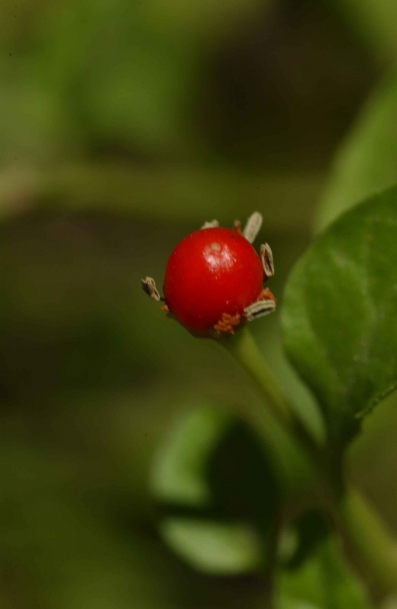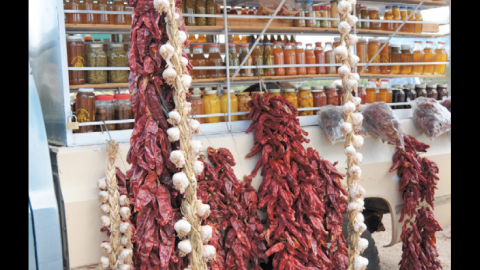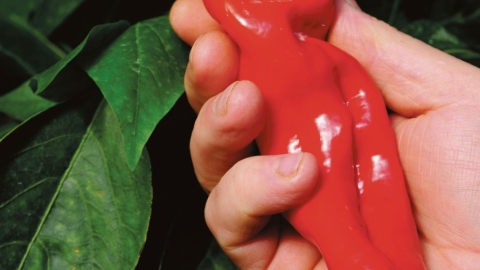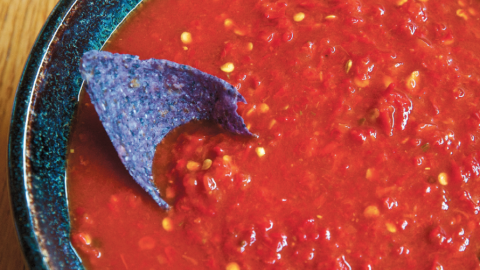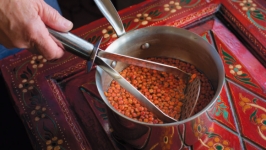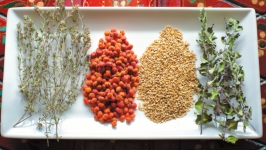Chiltepines: Hot and Wild Native Chiles
Recently, I’ve made sure my evening dog walks take me past two particular yards where I can check the progress of two special plants. I’m pretty sure the homeowners have not realized what is growing by their sidewalks. One plant is tucked underneath a struggling citrus tree; the other is at the base of a palm tree surrounded by flowers. As the small white flowers on the plants morphed into pea-sized green fruits, which are now turning red, I recognized both as wild chiles, unbidden and planted inadvertently, I suppose, by birds.
The plants look just like ones I’ve seen in the wild near the Arizona-Mexico border at Pedestal Rock Canyon in the Tumacacori Mountains, about 50 miles south of Tucson. Tumacacori is derived from a Native American name for “place where wild chiles are gathered.” Here grows the wild chile, widely known in the bi-national Sonoran Desert by its Mexican name, chiltepin, and treasured for its heat and distinctive taste. Found as far south as Peru, chiltepines in the wild reach their northern limit at Pedestal Rock Canyon.
Recognizing this unique resource, the U.S. Forest Service established the Wild Chile Botanical Area in 1999. It spans 2,500 acres and includes as many as 700–1200 wild chile plants any given year. The wild chiles are usually found growing beside larger trees and thorny shrubs. Under the protective canopy of these “nurse plants,” chiltepines find shelter from winter freezes, summer desiccation and damaging solar radiation.
The continuing study of wild chile ecology in this botanical area has helped scientists answer the important question of why chiles taste so hot. Chiles, say the experts, are hot basically because they are “for the birds.”
With their bright red color and presentation above the plant’s leaves, wild chile fruits catch the attention of birds in search of a nutritious meal. Mockingbirds, thrashers, cardinals, pyrrhuloxias and house finches harvest the ripe red chiles and benefit (as do humans) from the chile’s rich supply of vitamins A, C and riboflavin, as well as protein and fiber. By eating the chile fruit, birds help the next generation of chiles get started. The seeds go through their short intestinal tracts and are lightly scarified (etched) by digestive acids. Then, when the birds eliminate, the seeds are deposited (with some water and fertilizer) where they most like to grow: underneath nurse plants. Both chiles and birds benefit from this harvesting and planting arrangement.
Birds are not bothered by the chile’s heat; other animals are not so lucky. Although not toxic, chiles pack a loud warning to rodents, whose longer digestive system would likely destroy the seeds. This hot encounter convinces almost all mammals not to eat chiles, leaving more for the birds—and for people.
Chiltepines are called the mother of all chiles, not for their heat, but because they are the closest living relative of the earliest form of domesticated chiles. Thousands of years ago, indigenous people started growing wild chiles in their gardens and saved seeds from the biggest, best-tasting fruits for planting the next year. These selections slowly changed the plant, so that now the wide diversity of chile varieties can be sweet as bell peppers or hot as jalapeños.
By learning to enjoy the pleasure/pain of the chile bite, people have become the chile’s greatest ally. Because of this red-hot love affair, humans have been responsible for dispersing chiles around the world.
In northern Mexico, the chiltepin harvest is a big business and tons are exported yearly to the United States. Chiltepineros (wild chile harvesters) hand pick in the wild from late September to early December. Prices vary, but can reach $72 a pound.
Chiltepines are slightly stronger-tasting and hotter when they are freshly ripe from the plant, but dried and stored well they can keep for years. One or two pods added to a pot of beans or sprinkled over a plate of eggs is enough for most of us—although one self-proclaimed “chilehead” did tell me that he used to eat the entire jar of chiltepines that was a standard table spice at his family’s favorite Mexican restaurant in Yuma; the waiter would have to bring more for everyone else. Green chiltepines are sometimes pickled. Either pickled green or dried red chiltepines can be added to salsas for heat and flavoring.
Chiltepines have other traditional uses: an antioxidant to preserve dried meat, a treatment for acid indigestion, and a method to wean babies from breast-feeding. Another use I hear a lot about is tricking someone into eating it, often with the encouragement to “try this sweet berry.” As the birds know, it does look a lot like a desert hackberry or wolfberry. [Note: Some other desert red “berries” are poisonous, by the way, so it is imperative that you know what your are doing before attempting to eat what you think might be a wild chile either in the wild or from someone’s yard.]
Last summer, I took Scott Simon of National Public Radio to Pedestal Rock Canyon, and unfortunately we didn’t have enough time to find any wild chiles, which had decided to hide from us in the thick vegetation from the monsoon. Luckily, I had some dried chiltepines with me, and Simon had the classic reaction to their pungent heat. He choked up, his face went flush, his sinuses ran, and his eyes teared up. (You can hear the results of his encounter on the NPR website: www.npr.org/templates/story/story.php?storyId=5046579).
Scott was experiencing a feeling like that expressed by 18th century missionary Ignaz Pfeffercorn, who wrote in his journal of his encounter with wild chiles:
“After the first mouthful the tears started to come. I could not say a word and believed I had hell-fire in my mouth. However, one becomes accustomed to it after frequent bold victories, so that with time the dish becomes tolerable and finally very agreeable.”


